How to play vocal guitar solos in the style of John Mayer and Eric Clapton
A lesson in vintage '80s blues guitar, when guitars were pink, shoulder pads were big, and the melodies bigger still
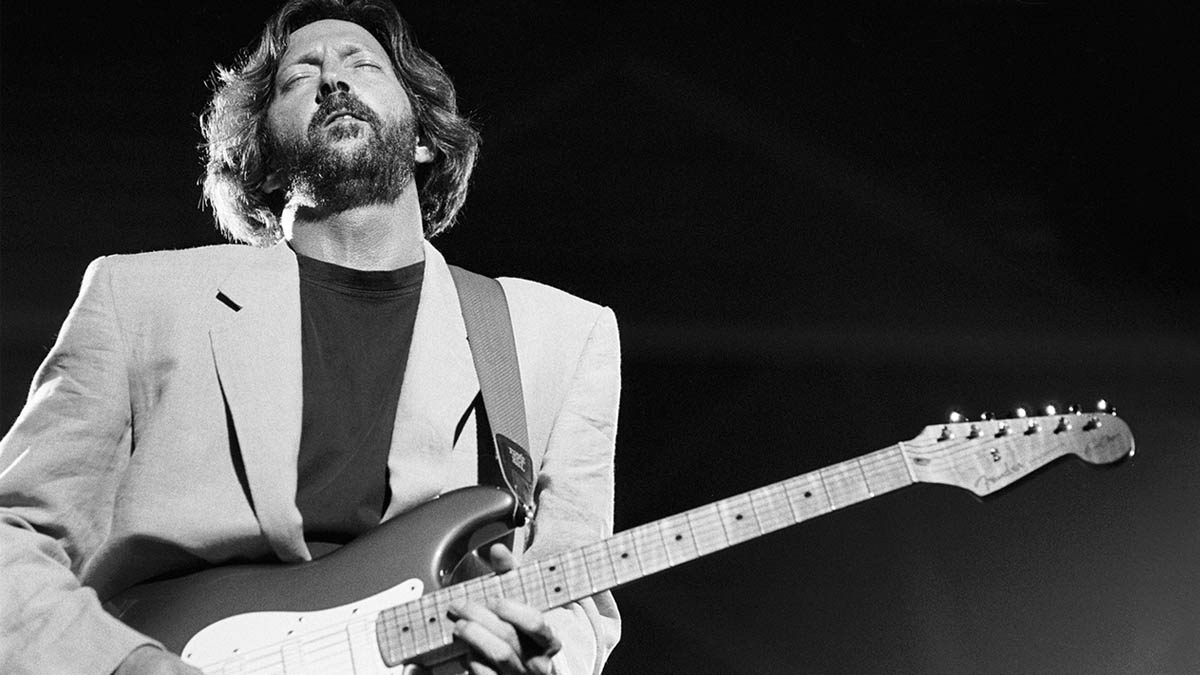
The 1980s are now long enough ago to generate some legitimate nostalgia. Those of us who were (ahem) there can recall heady summer days to the soundtrack of Journeyman-era Clapton and Toto. There was also a fad for brightly coloured guitars with pointy headstocks and locking whammy bars…
In John Mayer’s recent video for his own '80s-inspired journey, Last Train Home, he appears to have embraced the idea of bright pink electric guitars, but the phrasing is more Clapton inspired, with no divebombs! This installment of Blues Headlines is a look into that style – not an absolute clone of Mayer or Clapton but ‘vocal’ phrasing along those lines.
Beware of the twist in the backing track chord changes, which are laden with subtle traps: a full bar of F# diminished and an A major instead of the more pentatonic-friendly A minor are two of them. It’s still perfectly possible to take a pentatonic/blues approach, but it is a challenge.
The alternative approach of using diminished and major arpeggios (or fragments of these) moves away from the feel I was looking to highlight, so I opted for a more Clapton/BB King approach, adding a note here and there to the major or minor pentatonic, plus a few bends to push minor 3rds sharp over major chords. Remember when improvising that it’s perfectly okay to take your time between phrases; we’re not looking for anything too slick or jazzy.
In the accompanying video, you can see that I’m hesitant before playing some phrases, choosing carefully where to head after each pause. Admittedly, that’s partly because I was consciously going for a style, but it’s also because I’m trying to create melodic phrases like a vocalist rather than falling back on scales or licks. Most of the time, anyway…
Example 1
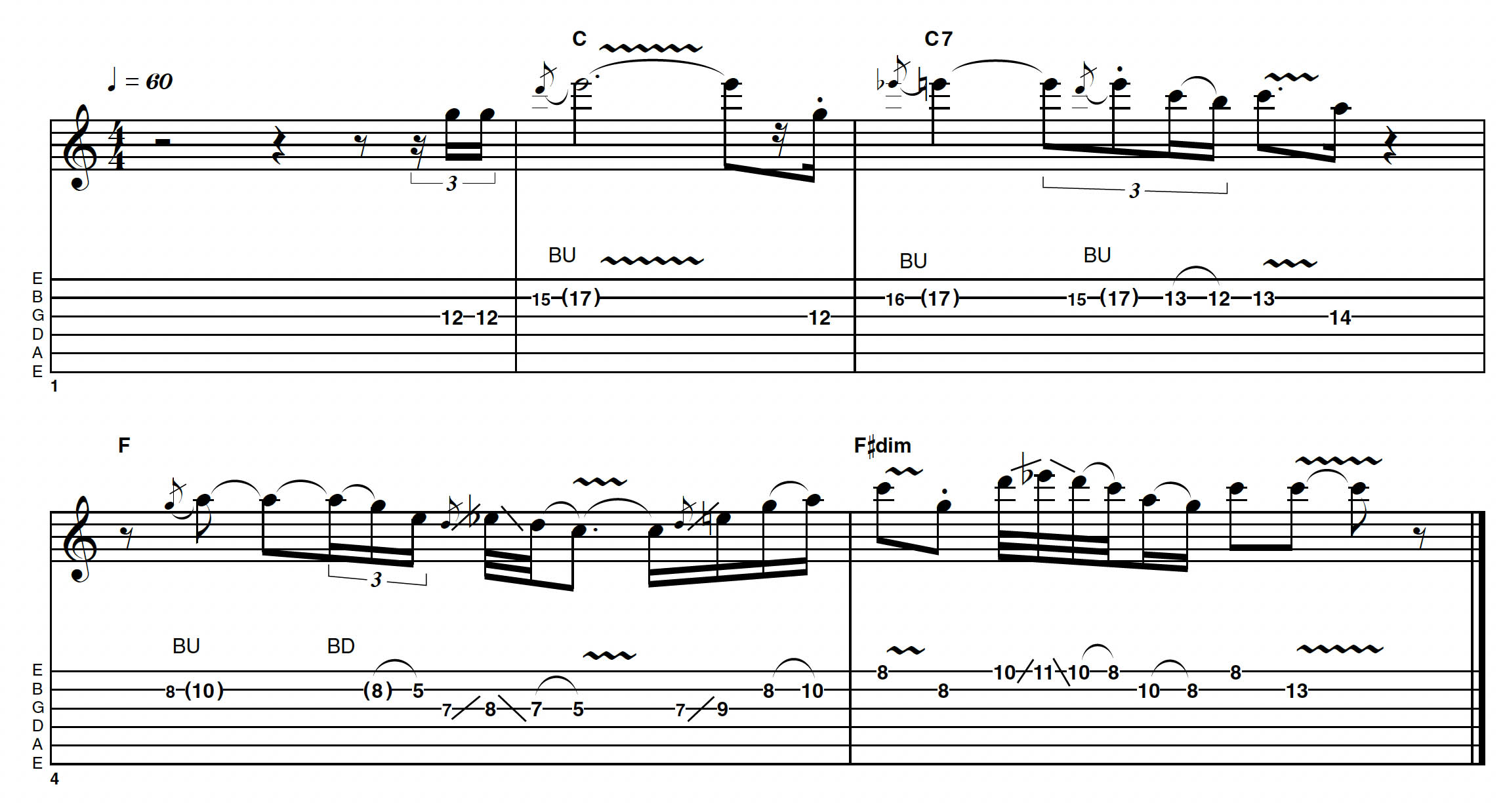
This opening phrase is very much pentatonic based, but using the pattern as a basis for a more ‘vocal’ approach, rather than trying to create licks or patterns.
I’m departing from the shape to bend up to that F at the start of bar 2 – and the B shortly afterwards is counterintuitive, though Clapton has often referred to a major 7th like this as a passing note. Jumping position briefly down to the A minor pentatonic, there is a shift back up to C via a little reference to the F# diminished chord in bar 4.
Example 2
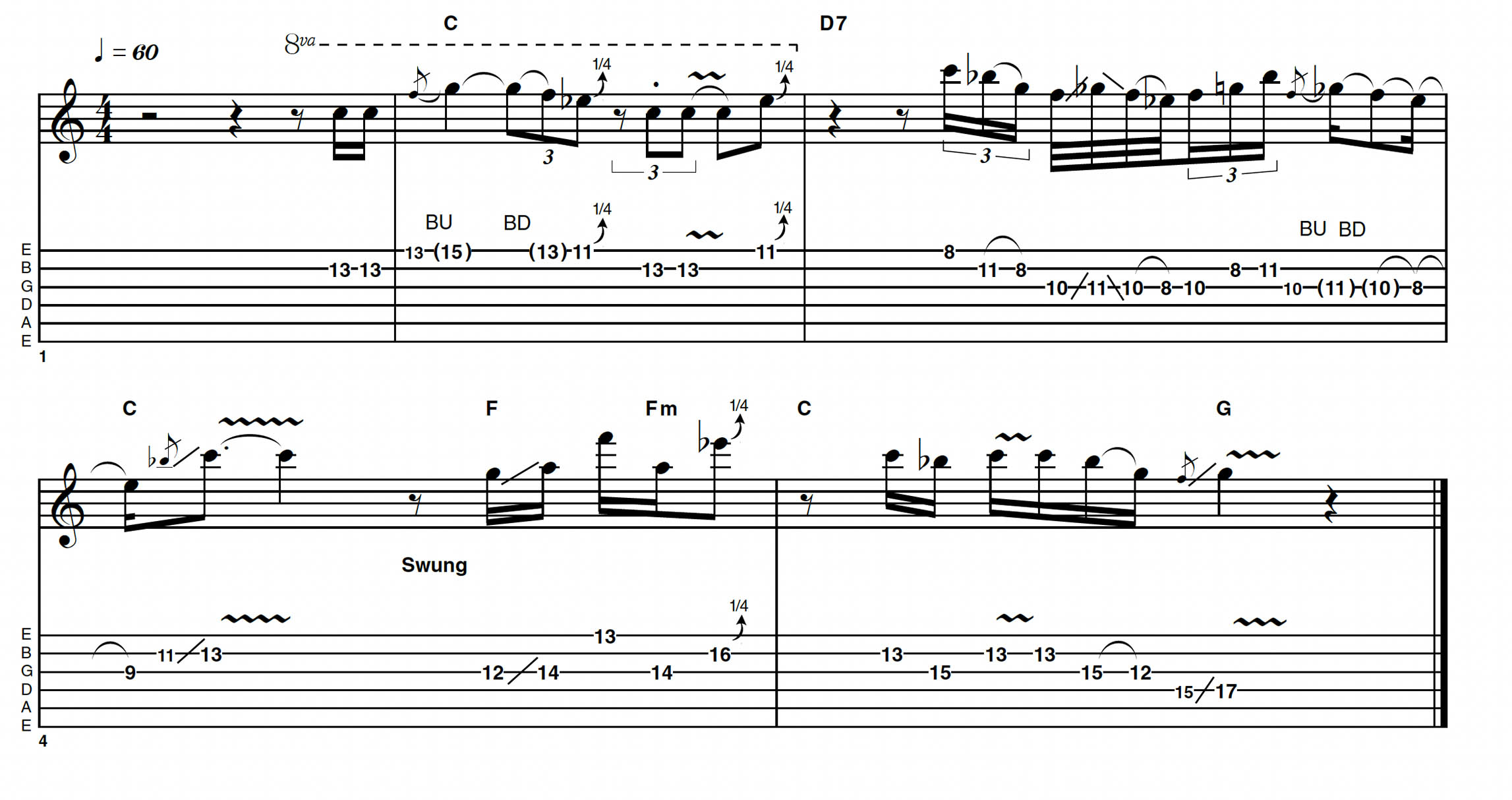
We’re treading a fine line in the first couple of bars, playing the C minor pentatonic over the A major chord with the only acknowledgement being the quarter-tone bend on the Eb in bar 1.
The timing is also hesitant, which is inspired by the way blues vocals are often sung behind the beat. The second half is more fluent, taking a pentatonic blues lick before sliding between positions to find a melodic line to wind up this half of the solo.
Example 3
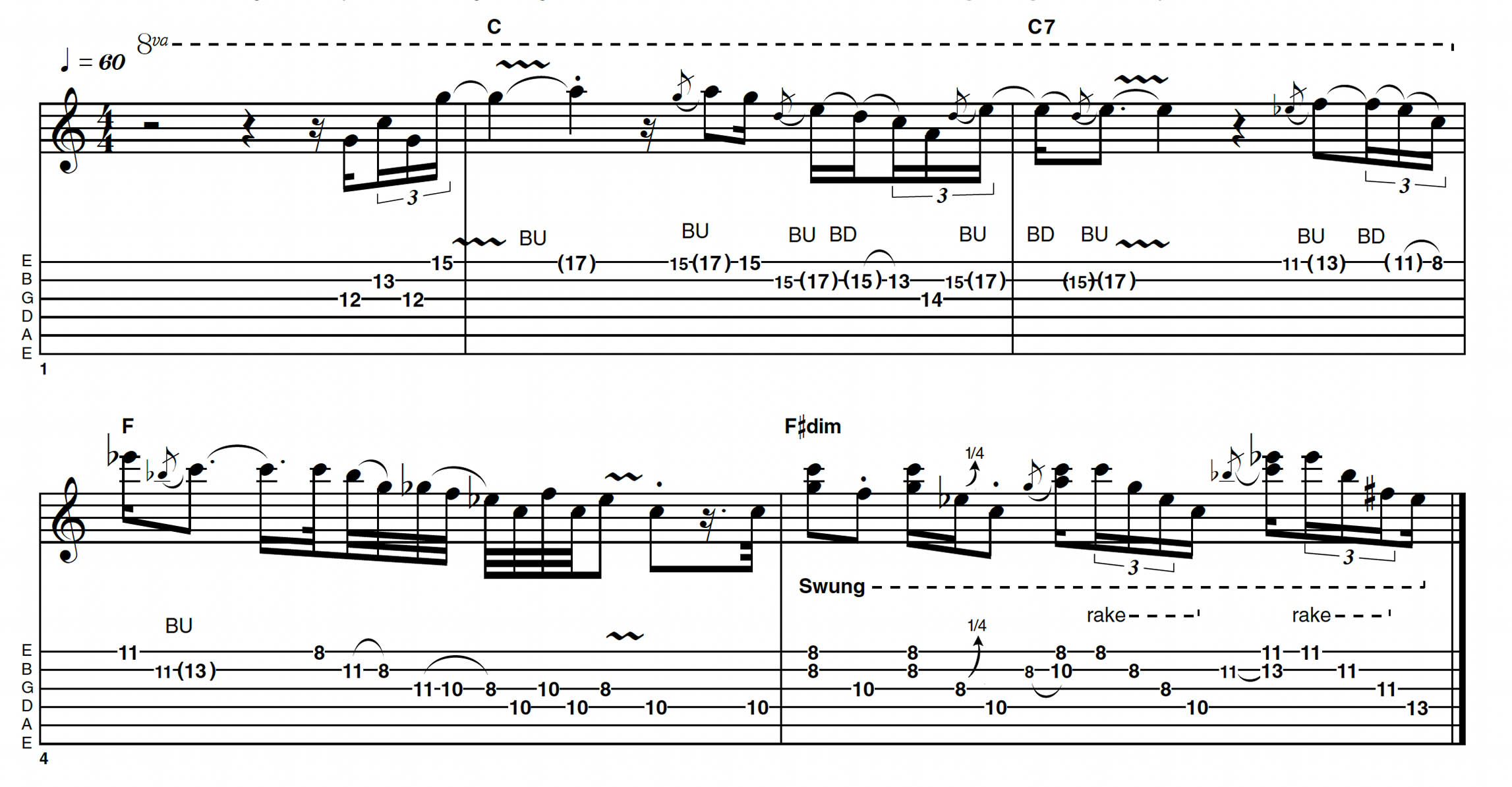
As the chord progression repeats, this alternative take on the first half deliberately avoids any overtly scale-type lines, then relenting in bar 3 to a classic blues scale run before a couple of Mayer-style doublestops, followed with a reverse rake across the strings.
I then realise, because the chord underneath is diminished, I can move this up three frets and still be in key, which paves the way nicely for a return to the home chord at the beginning of the final phrase.
Example 4
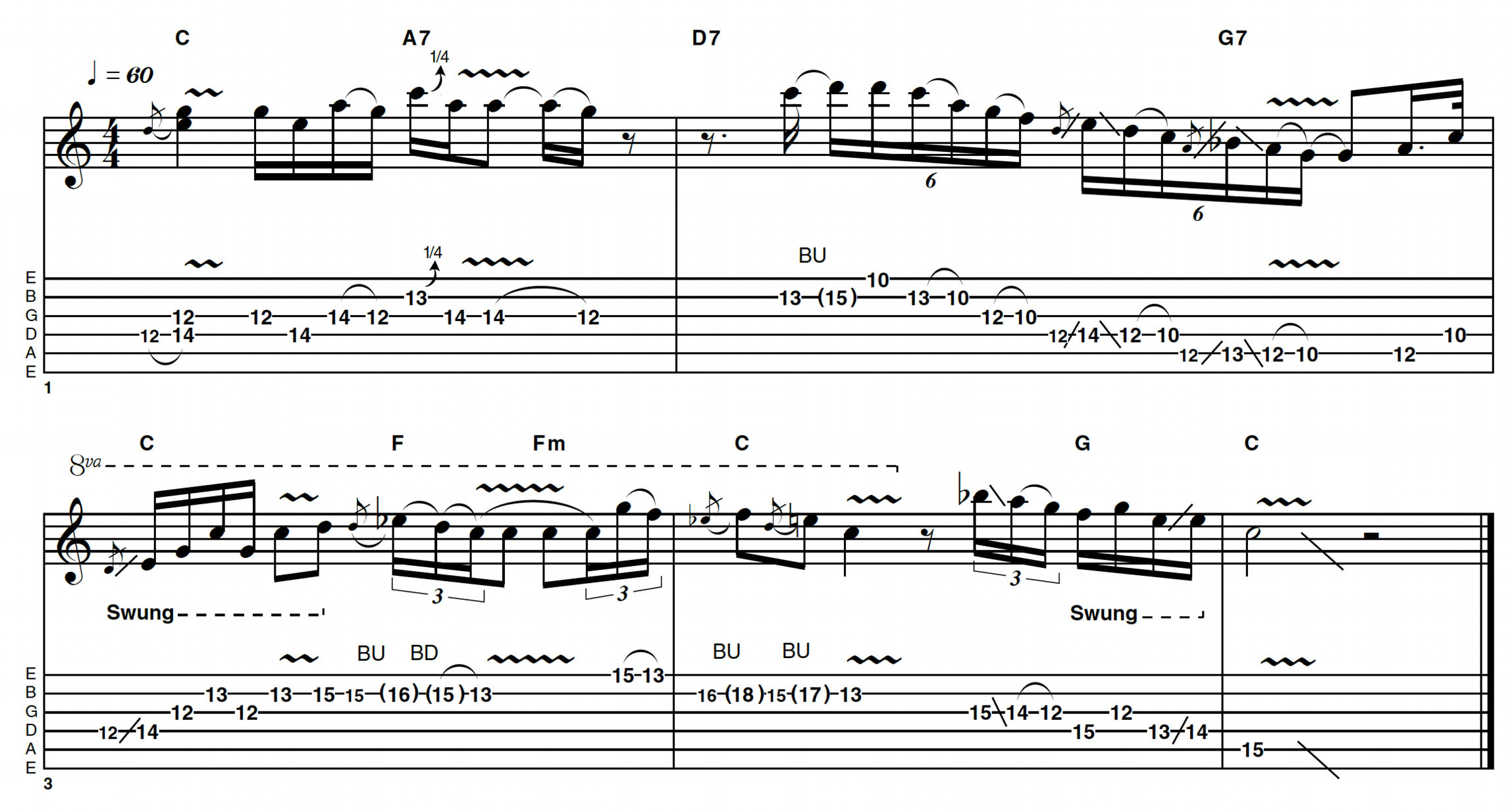
Coming straight from the doublestops over the diminished chord, I target a major 3rd (C and E) over the return to the home chord.
The C natural is pushed sharp as a token nod to the C# in the A major chord, but then we move on to the D and G major chords, where I play the dangerous game of sliding around a hybrid of the D minor and G major pentatonic, before returning to ‘home turf’ again with a phrase similar to example 1.
Hear it here
Eric Clapton – Journeyman
Having taken a more song-based approach on the previous album, August, with a more subtle guitar presence, this follow-up features a more ‘Eric’ style, with melodic blues phrasing on Pretending, more typical blues-infused solos on tracks such as Bad Love and Old Love – I guess the similar names would have ensured caution reading the setlist on tour, but these are very different tracks! Note how melody and expression take a similar approach to a vocal.
Toto – The Seventh One
Steve Lukather is perfectly capable of playing technical ‘outside’ jazzy lines, but frequently takes a more restrained blues-y approach, or takes a melodic line like a vocal.
This album includes many great guitar moments: Pamela features some classic Lukather blues/rock licks; A Thousand Years transitions from clean to distorted, keeping melody a priority, rather than fitting tricky licks everywhere; and These Chains is also classic Toto!
John Mayer – Sob Rock
At the time of writing, there are only limited tracks available from John Mayer’s latest album as a pre-release, but his playing on Last Train Home and I Guess I Just Feel Like are in a similar vein to what I was going for in this issue’s solo.
It will be interesting to see if he channels that ‘80s Clapton-style vibe in any of the other tracks when the album hits the streets and online – and it’s certainly nice to have some new material to look forward to.
Get The Pick Newsletter
All the latest guitar news, interviews, lessons, reviews, deals and more, direct to your inbox!
As well as a longtime contributor to Guitarist and Guitar Techniques, Richard is Tony Hadley’s longstanding guitarist, and has worked with everyone from Roger Daltrey to Ronan Keating.
“There are so many sounds to be discovered when you get away from using a pick”: Jared James Nichols shows you how to add “snap, crackle and pop” to your playing with banjo rolls and string snaps
Don't let chord inversions bamboozle you. It's simply the case of shuffling the notes around








![Joe Bonamassa [left] wears a deep blue suit and polka-dotted shirt and plays his green refin Strat; the late Irish blues legend Rory Gallagher [right] screams and inflicts some punishment on his heavily worn number one Stratocaster.](https://cdn.mos.cms.futurecdn.net/cw28h7UBcTVfTLs7p7eiLe.jpg)


